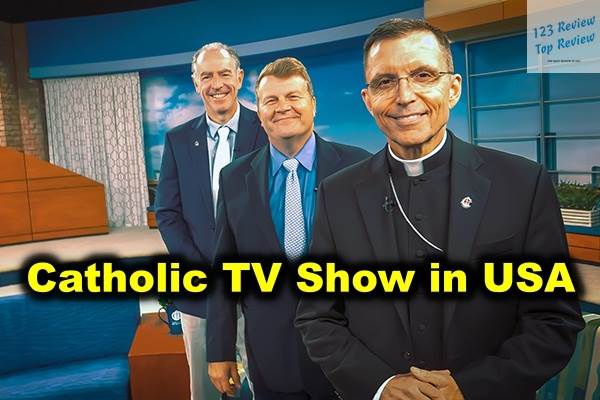In this article, 123 Review explores the early beginnings and key milestones of Catholic television, highlighting the significant impact of Vatican II on Catholic media. It reviews popular TV shows that cater to youth, families, and those seeking education and inspiration.
Additionally, the article examines audience engagement strategies, current trends, and the challenges faced by Catholic television networks. Insights into the future of Catholic television are also provided, emphasizing innovative content creation, global reach expansion, and strategies to attract younger audiences.
History of Catholic TV Broadcasting
Early Beginnings of Catholic Television
The origins of Catholic television broadcasting in the United States can be traced back to the mid-20th century. Initially, Catholic content was primarily broadcast via radio and public access television channels. The first significant effort in television was undertaken by the Paulist Fathers, who launched the “Insight” television series in 1960. This groundbreaking show addressed contemporary issues from a Catholic perspective, setting a precedent for future Catholic television programming. The program’s success demonstrated the potential of television as a medium for evangelization and education, paving the way for the establishment of dedicated Catholic television networks.

Key Milestones in Catholic Broadcasting
Over the decades, Catholic television in the USA has achieved several key milestones. One of the most significant developments was the founding of the Eternal Word Television Network (EWTN) by Mother Angelica in 1981. EWTN quickly grew to become a major force in Catholic media, providing 24/7 programming and reaching millions of households worldwide. Another important milestone was the establishment of CatholicTV in Boston in 1955, which has since expanded its reach and influence. In 2003, Salt + Light Television was launched in Canada, and it also garnered a substantial audience in the United States. These milestones reflect the growing influence and reach of Catholic television over the years.
Impact of Vatican II on Catholic Media
The Second Vatican Council (1962-1965) had a profound impact on Catholic media, including television. The Council’s decree on the media, “Inter Mirifica,” emphasized the importance of using modern communication tools to spread the Gospel. This led to increased investment in television and other media platforms, aiming to engage a broader audience and address contemporary issues from a Catholic viewpoint. The Council’s call for aggiornamento, or updating, encouraged the Church to embrace new technologies and methodologies in its mission of evangelization. This shift in perspective fostered a more dynamic and engaging approach to Catholic media, influencing programming and content creation in significant ways.
Popular Catholic TV Shows
Series Targeting Youth and Families
Catholic television offers a variety of programming specifically aimed at youth and families. Shows like “The Choices We Face,” produced by Renewal Ministries, address the challenges faced by young Catholics today and provide guidance on living out their faith in a secular world. “Super Saints,” an animated series, introduces children to the lives of saints in an engaging and educational manner. These programs help nurture faith from a young age and strengthen family bonds by providing wholesome and spiritually enriching content that can be enjoyed together.
Programs Focused on Catholic Education
Educational programming is a cornerstone of Catholic television. Shows like “Catholicism” by Bishop Robert Barron provide in-depth explorations of the Catholic faith, its history, and its teachings. This acclaimed series has been instrumental in educating viewers about the richness of the Catholic tradition and addressing common misconceptions. “The Journey Home,” hosted by Marcus Grodi on EWTN, features conversion stories and discussions about returning to the Catholic faith, offering a platform for individuals to share their personal journeys and insights. These programs serve as valuable resources for both lifelong Catholics and those interested in learning more about the faith, fostering a deeper understanding and appreciation of Catholicism.
Talk Shows Featuring Catholic Leaders
Talk shows are a popular format on Catholic television, offering viewers the opportunity to hear directly from prominent Catholic leaders and thinkers. Programs like “World Over Live” with Raymond Arroyo feature interviews with Church leaders, theologians, and laypeople discussing current events and issues facing the Church. These shows provide a forum for thoughtful and informed dialogue, helping viewers navigate complex issues from a faith-based perspective. “EWTN Live,” hosted by Fr. Mitch Pacwa, S.J., covers a wide range of topics, from theology to social issues, providing viewers with a deeper understanding of their faith and its application in the modern world. These programs are instrumental in connecting viewers with the broader Catholic community and fostering a sense of shared purpose and mission.
Audience Engagement Strategies
Utilizing Social Media to Reach Viewers
Catholic television networks have increasingly turned to social media to engage with their audience and expand their reach. Platforms like Facebook, Twitter, and Instagram are used to share clips, promote upcoming shows, and interact with viewers. By leveraging the power of social media, Catholic networks can connect with viewers in real-time, fostering a sense of community and immediacy. Live streaming of programs on social media platforms has also become common, allowing viewers to watch and engage with content as it airs. This approach not only broadens the audience base but also enhances viewer engagement by providing opportunities for interaction and feedback.
Opportunities for Community Involvement
Many Catholic television shows encourage community involvement through various initiatives and outreach programs. For example, EWTN hosts events and pilgrimages that bring viewers together in faith, offering opportunities for spiritual enrichment and fellowship. Local Catholic TV stations often partner with parishes and dioceses to broadcast community events, such as Masses, processions, and charitable activities, fostering a sense of connection and involvement among viewers. These initiatives help to strengthen the bond between the network and its audience, promoting a shared commitment to the values and mission of the Catholic Church.
Interactive Features in Programming
Interactive features such as live Q&A sessions, viewer polls, and call-in segments are used to engage the audience directly. These features make viewers feel like active participants rather than passive consumers, enhancing the overall viewing experience. Shows like “Called to Communion” invite viewers to call in with their questions about the Catholic faith, fostering a more interactive and personal connection. By incorporating these interactive elements, Catholic television networks can create a more dynamic and engaging viewing experience, encouraging active participation and fostering a deeper connection with the audience.
Current Trends in Catholic Television
Emphasis on Digital Streaming Platforms
The rise of digital streaming platforms has significantly influenced Catholic television, enabling networks to reach a global audience and provide content on-demand. Networks like EWTN and CatholicTV offer their programming through apps and websites, making it accessible to viewers anytime, anywhere. This shift to digital platforms allows viewers to watch content at their convenience, broadening the reach and impact of Catholic television. By embracing digital technology, Catholic networks can stay competitive in the ever-evolving media landscape and continue to fulfill their mission of evangelization and education.
Incorporating Modern Technology in Broadcasts
Modern technology has transformed the way Catholic television content is produced and delivered. High-definition broadcasts, drone footage, and virtual reality segments enhance the viewing experience, making it more visually engaging and immersive. These technological advancements help Catholic television stay competitive and appealing to a modern audience, providing high-quality content that meets the expectations of today’s viewers. By incorporating the latest technological innovations, Catholic networks can create a more compelling and impactful viewing experience, reaching a wider audience and fostering deeper engagement.
Collaborations with Other Faith-Based Networks
Collaborations with other faith-based networks and organizations are becoming more common, enabling Catholic television to broaden its reach and impact. These partnerships facilitate the sharing of resources, content, and expertise, enhancing the quality and diversity of programming. Joint productions and guest appearances by leaders from different faith traditions promote interfaith dialogue and understanding, fostering a spirit of cooperation and mutual respect. By working together, faith-based networks can amplify their collective voice and make a more significant impact on the media landscape, promoting shared values and principles.
Challenges Facing Catholic Television
Adapting to Changing Viewership Demographics
Catholic television faces the challenge of adapting to changing viewership demographics, particularly as younger generations consume media differently. Networks must find ways to appeal to younger viewers while retaining their traditional audience. This includes creating content that resonates with younger viewers, addressing their specific interests and concerns, and leveraging digital platforms where they spend their time. By understanding and responding to the preferences of a diverse audience, Catholic television can remain relevant and continue to fulfill its mission in a rapidly changing media environment.
Competing with Secular Programming
Competing with secular programming is another significant challenge for Catholic television. With the vast array of entertainment options available, Catholic networks must offer high-quality, engaging content to capture and retain viewers. This requires investment in production quality and innovative programming that stands out in a crowded media landscape. By consistently delivering compelling and spiritually enriching content, Catholic television can attract viewers and compete effectively with secular programming, ensuring its continued relevance and impact.
Financial Sustainability and Support
Financial sustainability is a critical issue for Catholic television networks, which often rely on donations and sponsorships to fund their operations. Securing consistent funding while maintaining the integrity and mission of the programming is a delicate balance. Networks must effectively communicate their value and impact to donors and sponsors, highlighting the positive influence of their programming on viewers’ lives. By building strong relationships with supporters and demonstrating accountability and transparency, Catholic television can ensure its long-term viability and continue to serve its audience effectively.
Future of Catholic Television
Innovative Content Creation Ideas
The future of Catholic television will likely see more innovative content creation, with a focus on original series, documentaries, and films that explore contemporary issues through a Catholic lens. Experimenting with new formats, such as podcasts and web series, can help attract a broader audience and provide fresh perspectives on faith and spirituality. By embracing creativity and innovation, Catholic television can produce content that resonates with viewers and addresses their needs and interests in meaningful ways.
Expanding Global Reach and Influence
Expanding the global reach and influence of Catholic television is a key goal for the future. With digital platforms, networks can reach viewers worldwide, spreading the message of the Catholic faith beyond geographic boundaries. Developing multilingual content and collaborating with international Catholic media organizations can further enhance this global presence, making Catholic television a powerful tool for evangelization and education on a global scale. By reaching out to diverse audiences and addressing their unique needs and concerns, Catholic television can foster a deeper understanding and appreciation of the Catholic faith around the world.
Strategies for Reaching Younger Audiences
Reaching younger audiences is crucial for the future of Catholic television. Strategies may include creating content that addresses the specific interests and concerns of younger viewers, using influencers and popular Catholic figures to engage them, and leveraging platforms like YouTube and TikTok where younger audiences are most active. By understanding the media consumption habits of younger generations and adapting content accordingly, Catholic television can build a strong connection with this important demographic, ensuring its continued relevance and impact in the years to come.
Catholic television in the USA continues to evolve, embracing new technologies and strategies to fulfill its mission of evangelization and education. By adapting to changing media landscapes and audience needs, Catholic TV networks can ensure their relevance and impact for generations to come. Through innovative content creation, expanded global reach, and effective engagement strategies, Catholic television can continue to play a vital role in spreading the Gospel and enriching the lives of viewers worldwide.





